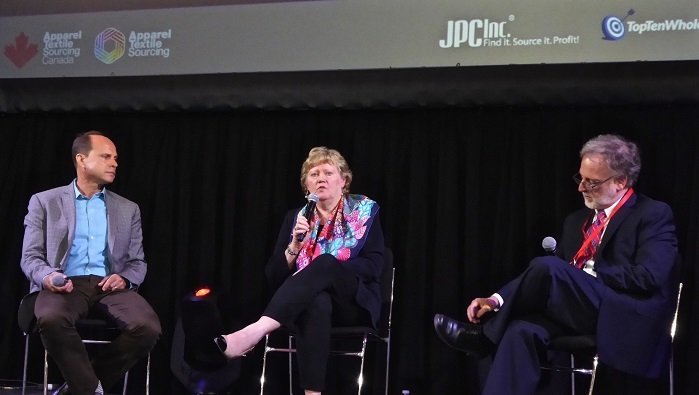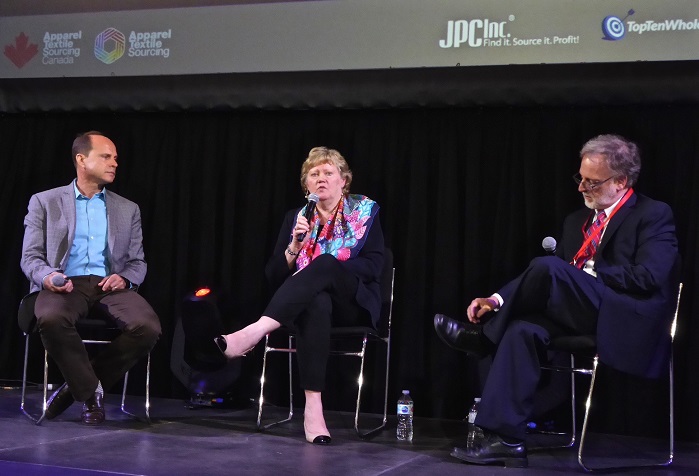
Cautious outlook for US fashion industry
Opinion


The United States Fashion Industry Association (USFIA) is dedicated to fashion made possible by global trade.

7th September 2018
Marie O'Mahony
|
Toronto
The United States Fashion Industry Association (USFIA) is dedicated to fashion made possible by global trade. This opening line on the website was used at the beginning of the association’s President Julia Hughes recent seminar in Toronto on US trade policy. The tagline is especially pertinent given the current policy being pursued by the US under President Trump and Hughes got directly to the point of the negative impact on the US fashion industry and globally.
Founded in 1989, the USFIA membership includes brands, wholesalers, retailers and importers. The organisation based in Washington, D. C. describes itself as “the voice of the fashion industry”, representing members interests at home and abroad. The proceeds of free-trade, eliminating tariff and non-tariff barriers is central to its mandate. The US Trade Commission estimated that in 2016 textiles and apparel accounted for 9.7% of imports from China, compared with 39% electronic products. However, the impact on the sector not just in the US but globally is of high significance to the industry. In an article titled ‘Walmart, Nike Suppliers Put on Notice by China Tariff Threat’ (6th March 2018) the Chinese and Hong Kong companies shown to be most at risk from Trump tariffs were Li & Fung with 64% of revenue coming from US, with the electronics company AAC Technologies were second at 62%.

Robert E. Lighthizer, the US Trade Representative insists that President Trump is fulfilling his election promise to push for trade reform to ensure “fairer outcomes for US workers and businesses, and more efficient markets for countries around the world…we have already begun to revise outdated and unfair trade deals, build a stronger US economy, pursue an aggressive enforcement agenda, and press for significant reforms of the WTO.” The impact of this agenda is already being felt within the US and globally. USFIA’s 2018 Benchmarking Study is based on a survey (undertaken April-May) of twenty-eight executives at leading US fashion companies. The top business challenge cited is the protectionist trade policy in the United States and the uncertainty this causes at very level from markets to supply chain and retail. This is echoed in a comment by Hun Quach, Vice President for International Trade at the (American) Retail Industry Leaders Association: “Virtually no sector will go unpunished. We’re really concerned about what this would do for the prices that American customers pay every day”. Linked to this is the third top challenge cited as increasing production and sourcing cost. If production and sourcing are repatriated to the US it will have a cost impact that will have to be passed on to the consumer who may choose to change their buying pattern or frequency.
So how much do US brands rely on overseas suppliers? The answer is a lot. Of those surveyed by USFIA eight out of the top ten sourcing destinations are in the southern hemisphere (in order): China, Vietnam, Indonesia, India and Bangladesh. Mexico came in ninth and USA tenth. With 48% of US textile and apparel imports coming from China, Julia Hughes puts it simply “China plus Vietnam plus many”. The USFIA survey found that sourcing from the Western Hemisphere (including members of NAFTA and CAFTA-DR) is increasing.
Utilisation of free trade agreements in the sector remains underutilised for sourcing. There is slight, though hardly significant, increase in the utilisation of NAFTA, CAFTA-DR and AGOA the main three FTA agreements for the US. On trade policy USFIA membership responding showed an overwhelming 77% support for reducing documentation requirements for importing and exporting textiles and apparel under FTAs. Administration time and complexity are proving to be a barrier to existing trade policy benefits that US fashion companies might avail of. Use of the exceptions to the ‘Yarn- forward’ Rules of Origin are a case in point. The US Customs and Boarder Protection Agency describe the requirements being: “the yarn used to form the fabric (which may later be used to produce wearing apparel or other textile articles) must originate in a NAFTA country”. This may seem fairly straightforward until the customs web site continues in a Monty Pythonesque fashion: “Thus, a wool shirt made in Canada from fabric woven in Canada of wool yarn produced in Argentina would not be considered originating since the yarn does not originate within a NAFTA country. If, however, Argentine wool fibre was imported into Canada and spun into wool yarn, which was then used to produce the wool fabric, the shirt would be considered originating”. This is before getting to the actual paperwork. It is hardly surprising that such benefits to brands are out of reach for logistical reasons. Many respondents said they did not use the short supply list mechanism because the documentation requirements were too complicated, while even more said they did not use the cumulation rule because they did not know what it was.
The World Bank describes the rule whereby “cumulation allows producers to import materials from a specific country or regional group of countries without undermining the origin of the final product”. However, the interpretation of this rule is not entirely transparent as in two examples given by the Canadian law firm, Bennett Jones. The final assembly of the Apple iPhone takes place in China. Yet the added-value in China is less than 2% (2014 figures) and the applicable US Rule of origin confers origin on China. The second example given by Bennett Jones is a Tee-shirt produced in Bangladesh that imports around 80% of its yarn. The yarn-forward rule then means that apparel goods made up in the country often does not necessarily qualify for preferential treatment under FTAs. The outcome is low utilisation of trade preferences for apparel. While a company like the VF Corporation may have the resources to untangle such regulations a SME does not, putting them at a competitive disadvantage.
In conversation with Julia Hughes she is clear about the single biggest challenge facing the industry and it is uncertainty. While she would speculate on likely scenarios under the Trump administration, she would not be drawn on future trade between US and UK under BREXIT. America, like the rest of the world it seems will have to wait and see.

Business intelligence for the fibre, textiles and apparel industries: technologies, innovations, markets, investments, trade policy, sourcing, strategy...
Find out more